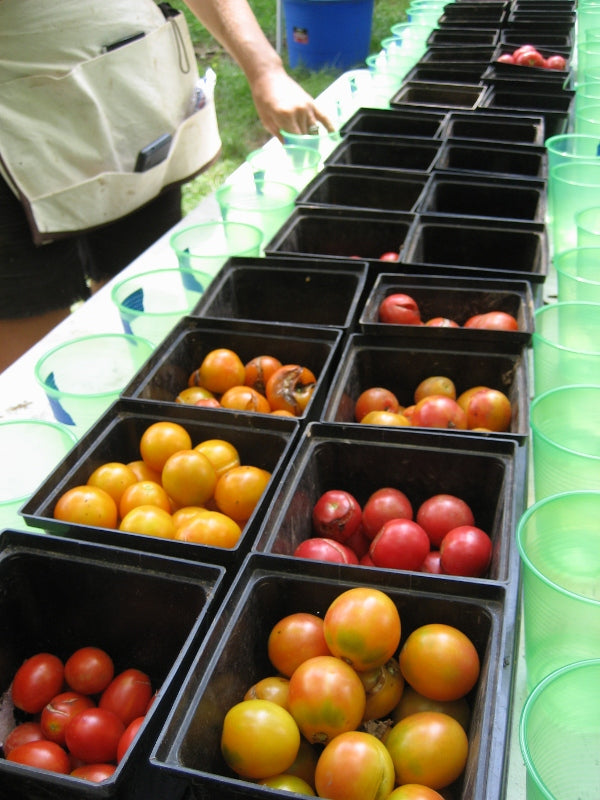It's seed collecting time! We're processing Upstate Oxheart, Stone Ridge Tomato (formerly known as Ulster Germaid), Isis Candy Shop Cherry Tomatoes every day along with Spider Flowers. Our Japanese Cucumbers, Blacktail Mountain Watermelon, Cocozelle Zucchini, Flashy Butter Oak Lettuce, Calendula, and Piracicaba Broccoli are almost ready to start harvesting for seed. What are you saving for seed this season? Whatever it is, it's time to open up your Membership Pack, take out the seed saving envelopes, and get seedy.
The first seed return of the year just came in from Margaret Roach who saved five ounces of Breadseed Poppies from her garden for the Seed Library. Five ounces may not sound heavy, but it's about 300,000 seeds! Of course, we don't expect anyone to return such quantities of seeds. Margaret is clearly an over achiever, and we thank her for it! Depending on the variety, one tomato, or one pepper, or one cucumber, or one flower head often contain more seeds than you checked out.
Why is it so important for you to return some seed saved in your garden? You are our all-important in-situ preservationists.
Seed banks, many of which focus on native and wild plant varieties, have two main ways of thinking about seed preservation: ex situ and in situ. Ex situ conservation means off-site conservation--storing and growing a seed and plant outside of its natural habitat. Usually, these seeds are not available to the public. In situ refers to seeds and plants being protected and conserved in their natural environment. For example protecting and maintaining a prairie meadow. Again, these seeds and plants would not normally by accessible for the public to grow.
Here at the Seed Library we also think in terms of ex situ and in situ seeds. Our ex situ seeds are the ones grown on our seed farm or grown by other seed producers. Seed farms are their own special kind of farm, different from food production farms. They are close, but not quite the same as the natural habitat for the seeds.
But what does in situ mean for the cultivated varieties? Your garden.
The "native habitat" of most of the varieties we offer has become tended garden plots and small diversified farms. This cultivated landscape bridges the wild past of the seeds we depend on with the human collaboration needed to keep them alive. Unlike the banking model, we have chosen to use the library model because we want our seeds to be accessible to the general public. This ensures their continued growth in their natural habitat.
While our own library of seeds from our seed farm is a growing collection, what makes our seed library a living collection is when our members return seed they've saved from their own gardens and farms. Our library is healthiest when the ex situ become in situ and the in situ return to the library. This continual exchange, from hand to hand, person to person, garden to seed farm, keeps varieties dynamic—changing with the ever changing conditions of the climate, disease pressures, and human desires.
You can help keep seeds spiraling up and out to gardens and back into the Seed Library.
If you're up for the adventure, try to save seed from the healthiest plants, most delicious varieties, and most beautiful flowers. Stick to saving seeds within your skill level. If you don't yet know how to hand-pollinate or build an isolation cage, save seeds from beginner varieties. Some plants will produce an abundance of healthy seed just through benign neglect. Every time you save seeds from strong plants you are helping to improve the variety, keeping it healthy, helping it adapt to our region, and passing on the best genes to the next grower—which may be you!
You can get up to speed with seed saving how-to by looking back at previous blog posts:
Tomato Smash Up: How to Save Tomato Seeds
Seed's Eye View Part 1: Seed Saving for Beginners








